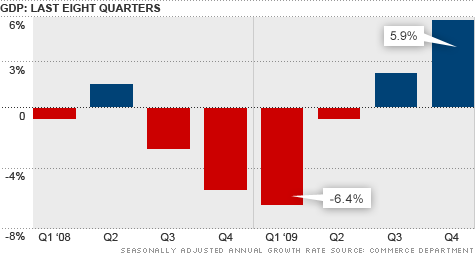
NEW YORK (CNNMoney.com) -- The U.S. economy grew at a slightly faster pace than originally thought during the last three months of 2009, according to a government report Friday.
The nation's gross domestic product, the broadest measure of the nation's economic activity, grew at an annual rate of 5.9% in the quarter, the Commerce Department reported. Economists surveyed by Briefing.com had forecast that the revision would show the same 5.7% growth that was originally reported a month ago.
The report is another sign that the U.S. economy has pulled out of the deepest downturn since the Great Depression. The solid growth, the best improvement for the U.S. economy in more than six years, follows a 2.2% annualized increase in the third quarter. Most economists now agree that the recession probably ended at some point last summer.
Still, the strong end of 2009 wasn't enough to make up for the even larger declines in the first half of the year. For the full year, GDP fell 2.4%, the biggest decline in the annual reading since 1946.
The recovery is widely perceived as fragile. Federal Reserve Chairman Ben Bernanke testified to Congress this week that the central bank will need to keep interest rates low in order to support the economy.
The recovery is even less apparent to the typical American. Job losses have continued in all but one month and most economists believe unemployment will stay close to 10% for much of the year.
Credit remains tight for small businesses and consumers and the recovery in housing prices is uneven at best. The most recent survey of 5,000 American consumers by the Conference Board found the greatest level of worry about the current state of the economy in 27 years.
"The fourth quarter GDP revision tastes great, but is less filling," said Robert Dye, senior economist of PNC Financial Services Group. "We need the meat and potatoes of private-sector job creation in order to sustain this recovery."
This GDP reading showed consumers still very much on the sidelines, as spending by individuals increased at a far more modest 1.7% annual rate in the quarter. Instead, it was businesses and the federal government that led the way on growth.
More than half the growth in the quarter was due to the fact that businesses were no longer slashing inventories the way they did in the first three quarters of the year. Spending on equipment and software, often seen as a proxy for business investment, grew at an 18.2% rate in the period.
Nondefense spending by the federal government grew at an 8.3% rate. But budget-strapped state and local governments cut spending at a 2% rate, while defense spending fell 3.5%, leading to a decline in overall government spending.
A 22% rise in exports also was a major contributor to growth.
The lift from the rebuilding of inventories and the government stimulus package passed last year is expected to wane later this year, meaning growth will likely slow to a more modest rate. Economists surveyed by the National Association of Business Economics forecast 3.1% growth this year and 3.2% in 2011. ![]()






| Index | Last | Change | % Change |
|---|---|---|---|
| Dow | 32,627.97 | -234.33 | -0.71% |
| Nasdaq | 13,215.24 | 99.07 | 0.76% |
| S&P 500 | 3,913.10 | -2.36 | -0.06% |
| Treasuries | 1.73 | 0.00 | 0.12% |
| Company | Price | Change | % Change |
|---|---|---|---|
| Ford Motor Co | 8.29 | 0.05 | 0.61% |
| Advanced Micro Devic... | 54.59 | 0.70 | 1.30% |
| Cisco Systems Inc | 47.49 | -2.44 | -4.89% |
| General Electric Co | 13.00 | -0.16 | -1.22% |
| Kraft Heinz Co | 27.84 | -2.20 | -7.32% |
|
Bankrupt toy retailer tells bankruptcy court it is looking at possibly reviving the Toys 'R' Us and Babies 'R' Us brands. More |
Land O'Lakes CEO Beth Ford charts her career path, from her first job to becoming the first openly gay CEO at a Fortune 500 company in an interview with CNN's Boss Files. More |
Honda and General Motors are creating a new generation of fully autonomous vehicles. More |
In 1998, Ntsiki Biyela won a scholarship to study wine making. Now she's about to launch her own brand. More |
Whether you hedge inflation or look for a return that outpaces inflation, here's how to prepare. More |